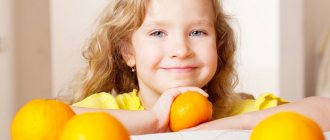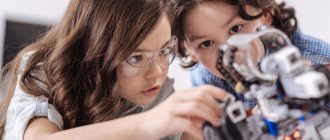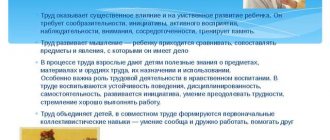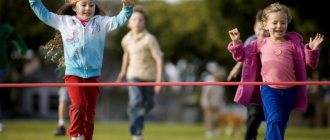Types of applique classes in the senior group
Familiarizing children with folk ornaments and methods of decorating surfaces with patterns of varying degrees of complexity forms the basis for teaching decorative appliqué in kindergarten.
In classes in a preschool institution, decorative applique with a ribbon and central-radial composition is used. In a strip construction, individual elements can be repeated horizontally or vertically many times in the form of a frieze, border or border. The pattern can be simple, consisting of one element, or complex, in which a separate motif is repeated after two or three elements. In a central-ray composition, the pattern develops in the direction from the center of the decoration evenly to the edges, corners, sides, depending on what shape it is located on: a circle, a rectangle, a square (skullcaps, carpets, pillowcases, etc.).
A composition in the form of a flower bouquet or a colorful flowerpot can be used in decorative appliqué. Such decorations are often found in Ukrainian and Polish cuttings made of multi-colored paper when making large-sized wall decorations. They are characterized by a special decorativeness and elegance, which is emphasized by the symmetrical arrangement of the constituent elements.
The construction of ornamental elements according to the laws of composition depends on the shape and purpose of the objects, as well as historically established national traditions of ornamentation.
To reproduce different types of ornaments, preschool children must learn to evenly fill the background space with individual elements and highlight the main and auxiliary parts of the applique. In order to develop children's eye and ability to create balanced compositions, it is advisable to use visual teaching techniques or limit themselves to verbal instructions if preschoolers are well aware of the methods of cutting out and pasting individual elements. At the same time, it is important to direct the child’s thoughts to search for independent ways to complete the pattern and its creative interpretation. Every time children should be convinced of the possibility of creating new, original combinations of patterns, which is an important incentive for their active, creative attitude towards meaningful activities.
How successfully preschoolers will master the methods of constructing ornaments largely depends on the interaction of two types of activities - decorative appliqué and decorative drawing. This combination of ornamental creativity helps to consolidate the learned techniques and transfer them to another, more complex type of activity, which differs in the technique of making patterns.
A beautifully selected color scheme of a pattern is the most important means of aesthetic education of a child, developing his ability to perceive color and its harmony. Therefore, it is necessary to purposefully develop in a child a sense of color, the ability to select bright and soft colors, using not only spectral colors, but also a variety of halftones and shades, smooth color transitions.
Materials and equipment for appliqué classes……………………6
3. Application training program for senior children………………8
4. Practical part: Methods and techniques of teaching…………………….…11
Conclusion………………………………………………………………………………………..21
List of sources used……………………………………22
Introduction
Introducing a child to the world of beauty reveals to him the richness and beauty of the surrounding life, contributes to the development of the need not only to contemplate the world, but also to actively understand and transform it.
V. A. Sukhomlinsky said that a child by nature is an inquisitive researcher, a discoverer of the world, that a child’s heart is sensitive to the call to create beauty. It is only important that calls are followed by work, so that work becomes a necessity.
You will learn how great the potential is for one of the common types of fine art - appliqué - for the formation of the mental and creative abilities of a preschooler, for the development of his moral ideas, work skills, and artistic taste.
1. General characteristics of application as a type of visual activity for preschool children
Applique (from the Latin word “attachment”) is an interesting type of artistic activity - it is a way of working with colored pieces of various materials: paper, fabric, leather, fur, felt, colored beads, beads, woolen threads, embossed metal platinum, all kinds of matter (velvet , satin, silk), dried leaves... this use of various materials and structures in order to enhance expressive capabilities is very close to another means of representation - collage.
The application was born a long time ago. It appeared as a way to decorate clothes and shoes, household utensils and tools, and the interior of your home.
Perhaps the first impetus for the appearance of appliqué was the need to sew skins for clothing, and the first stitch told a person that they could not only connect the details of clothing, but also decorate it. Parts cut from these materials began to be attached to clothing. This is how the application appeared.
The subject matter included animals, birds, people themselves, fantastic monsters, beautiful flowers and plants, scenes of hunting and everyday life.
Applications are accessible even to young children: creating a whole from existing parts is much easier than creating the same design from a mosaic.
Parts of the applique can be prepared in advance and given to the child to create an image, but the mosaic cannot.
When working on the applique, they use glue, scissors, colored paper (which you can make yourself using paints or felt-tip pens), wrapping paper, magazines, foil, candy wrappers, foam rubber and simply unexpected materials.
The concept of “appliqué” includes methods of creating works of art from materials that differ in their properties and texture, united by the similarity of the execution technique. Each material has its own characteristics, which have a decisive influence on the application technique. For example, paper, straw, dried plants, birch bark are attached to the background with various adhesives; poplar fluff is placed on velvet paper.
Applique is the simplest and most accessible way to create artwork, which preserves the realistic basis of the image itself. This makes it possible to widely use applique not only for design purposes, but also in creating paintings, panels, ornaments, etc.
The main features of the appliqué are silhouette, flat generalized interpretation of the image, locality of large color spots.
The application can be substantive, consisting of individual images; plot, reflecting a set of actions and events; decorative, including ornaments and patterns that can be used to decorate various objects.
Preschoolers master all the processes of making appliqué—cutting and gluing shapes. Preparatory exercises for mastering this type of activity are games with mosaics, with the help of which children, laying out ready-made geometric shapes, become familiar with their features, color, arrangement methods, and principles of creating a pattern. Cutting out without gluing helps master the applique process (children cut paper, making tickets, flags, etc. for games, learn to use scissors). In kindergarten, they use such types of applique work as gluing ready-made shapes (decorative - from geometric and plant shapes and object - from individual parts or silhouettes) and cutting and gluing forms (individual objects, plot, decorative). Preschoolers can cut out shapes in sections or as a silhouette. Composing an object from separate parts is easier for them, like any constructive image in drawing or modeling. Silhouette cutting is more difficult for children, since they always need to compare the general contours of the object with the proportions of its individual parts. Therefore, cutting out complex shapes is included in the program only in the preparatory group. The application contains great opportunities for the development of imagination, imagination, and creative abilities of children. Thus, the pattern can be made up of both ready-made geometric and plant shapes cut out by the children themselves. The use of ready-made forms in decorative works allows preschoolers to focus all their attention on the rhythmic alternation of elements in a pattern and the selection of beautiful color combinations. Children use the skills acquired in appliqué classes in other activities, mainly in design, making shadow theater, light decorations, and Christmas tree decorations.
MAGAZINE Preschooler.RF
“Application as an effective means of developing cognitive activity”Preschool age is the most sensitive period for assimilating the artistic experience accumulated by humanity (Komarova T.S., Mukhina T.S., Sakkulina N.P., etc.). Visual activity of preschool children is considered by psychologists and teachers as a complex analytical-synthetic activity, which is characterized by the creative implementation of a plan (Vetlugina N.A., Ignatiev E.M., Komarova T.S., etc.).
Application acts as a specific form of artistic knowledge for children and promotes the gradual assimilation and understanding of the uniqueness of expressive and visual means that stimulate the cognitive need, curiosity develops under certain conditions into inquisitiveness, gradually developing cognitive interests, and then into the need for systematic active assimilation and independent use of knowledge , abilities, skills.
This activity helps the development and formation of visual perceptions, imagination, spatial concepts, memory, feelings and other mental processes. Such personality traits as perseverance, focus, accuracy, hard work,
important for the development of fine motor skills of the fingers, their muscles, and coordination of movements.
Applique is a type of fine art, an artistic technique based on cutting, overlaying and fixing details on a background. This is the simplest and therefore most accessible way of performing artistic work, which preserves the realistic basis of the image itself. As a result, it becomes possible to widely use appliqué not only for design purposes, but in creating images in the classroom and in the independent creative activities of preschoolers.
Cognitive activity in preschool children in applique is considered as the assimilation of accessible artistic experience and proactive, independent and creative (at the level of age capabilities and characteristics) use of it in their own applicative activities. The uniqueness of a child’s cognitive activity is determined by the fact that it is formed in close connection with productive activity, with the development of manual labor skills.
When determining cognitive activity and expressiveness in application, the initial data were general methodological provisions about the essence of the artistic image in the fine arts and the specifics of its formation in preschool children. In their works, preschoolers not only reflect the surrounding reality, but also give it an emotional and personal assessment.
The most characteristic features of the application are:
- stylization, i.e. simplified image based on the transfer of essential features, abstraction from secondary properties, detail
- decorativeness of the image, characterized by the stylization of the image, the constructiveness of the composition, the decorativeness of the color, the technicality of the appliqué elements on the background.
Currently, a wide variety of elements can be used in applique: various types of paper, fabric, threads, straws, fur, shells, sand, birch bark, dried plants, leaves, seeds and other natural materials.
Types of application:
Subject, consisting of individual images (leaf, branch, tree, bird, flower, animal, person, etc.);
Tasks:
- to form in children a cognitive interest in the world of objects in nature, man-made things, and people; careful attitude to the world of objects
- evoke in children a desire to express their attitude towards objects in applications
- encourage children to accept and independently formulate the themes of the image
- form generalized ideas about the depicted object, stimulate independence and creativity in conceiving an image
Plot, reflecting certain events;
Tasks:
- develop interest in surrounding objects and natural phenomena
- develop in children an understanding of the dependence of image quality on the quality of observation
- Encourage children to independently conceive an image
- teach children to feel the expressiveness of the image, encourage them to have an emotional response to it.
Decorative, including ornaments and patterns that can be used to decorate various objects.
Tasks:
- formation in children of emotional responsiveness and interest in objects of art, understanding of its features
- developing a desire to engage in such activities at the suggestion of an adult and on one’s own initiative
- the formation of generalized knowledge and corresponding visual (applicative) skills - children’s mastery of characteristic elements and painting patterns; nurturing a sense of rhythm, form, symmetry
- nurturing activity, independence, initiative and creativity when creating applique patterns.
Currently, teachers of preschool educational institutions are inclined to the traditional technique of teaching children applications, namely:
- Create a decorative pattern from various paper geometric shapes and plant (leaf, flower) details, placing them in a certain rhythm on a cardboard base.
- Compose an image of an object from colored paper from separate parts; depict the plot.
- Master various techniques for obtaining parts for appliqué from paper: cutting with different techniques, tearing, weaving; as well as the technique of attaching them to the base.
- Create an image of an object (plot) using the origami technique.
The work also uses non-traditional appliqué techniques.
Working with various materials, in various artistic techniques expands the child’s capabilities, develops a sense of color, harmony, imaginative space, imaginative thinking, and creative abilities.
Correctional work using visual arts (applications) should take into account the qualitative uniqueness of children associated with the underdevelopment of their cognitive activity. Therefore, one of the tasks of teaching children ZPR is to saturate their applicative work with substantive, semantic content. In such children, emotional involvement plays a special role.
Stages:
- Formation of motivational and guiding foundations of visual activity.
- Formation of basic skills in visual arts (application) in the process of a child mastering ways of reflecting the external qualities of objects.
- Development of skills in productive visual activity at the visual-figurative level (at the level of presentation).
- Creative visual activity at the level of imagination, which is based on the child’s high emotional involvement in the application process.
When performing correctional pedagogical work using visual arts for children, the following principles must be taken into account:
- developing in children the idea that any image is a reflection of real objects of the surrounding reality and social phenomena
- taking into account the patterns of development of visual activity in the norm and taking into account the peculiarities of the development of visual activity in children with various developmental disabilities
- close relationship between visual activity and various types of children’s activities - subject-matter, play, work and communication
- the relevance of the social orientation of visual activity in the selection of methods, techniques and content of training
- emotional involvement of the child in the process of creating images at all stages of learning
- development of all aspects of speech as an integral part of the process of formation of visual activity (applications)
- the process of creating images is unthinkable without educating children in aesthetic culture and artistic expression.
Corrective applique classes contribute to:
- Children develop observation skills;
- techniques for examining the depicted object are being improved;
- children master specific perception - the ability to see an object holistically, in the unity of its properties;
- complete and accurate ideas about objects and phenomena of the surrounding world are formed, since the image of objects requires a clear identification in the mind of essential features relating to shape, design, size, position in space and other parameters;
- children not only reproduce what they saw, but based on the received ideas about objects and phenomena of the real world, they create new original works in the application. This is achieved through the development of imagination, the basis of which is the ability to operate with ideas in the mind and transform them;
- visual and motor memory also develop, since in the process of visual activity it is important not only to be able to perceive objects and work with a pencil and scissors, but also to consistently reproduce with your hand what you saw with your eyes;
- Children learn in the process of productive activity to depict objects, i.e. capture ideas about it and the way it is depicted;
- During fine arts lessons (applications), children improve all their mental operations through visual and practical activities.
Material and technical means.
Learning appliqué involves familiarizing yourself with the material, acquiring the ability to cut out various shapes, arrange them on a sheet of paper in a certain order and paste them in accordance with the image and plot.
The main objectives of application training are as follows:
- distinguish geometric shapes, know their names (circle, square, oval, rectangle, triangle, rhombus)
- introduce primary, complementary colors and their shades, mastering the ability to create harmonious combinations
- know sizes and quantities: large, small shapes; one form is larger (smaller) than another, one, several, many forms
- develop compositional skills: rhythmically arrange identical forms in a row or alternate two or more forms; build an image depending on the shape of the sheet - on a strip, square, rectangle, circle
- create an image of an object from separate parts
arrange objects in a plot applique.
Mastering basic cutting techniques: a) cutting paper straight, along folds and by eye; b) cutting out rounded shapes by rounding corners, symmetrical shapes from paper folded in half, several times, like an accordion; c) cutting out asymmetrical shapes - silhouette and from separate parts; d) cutting along the contour; e) creating a shape by tearing off pieces of paper.
Mastering basic gluing techniques (using a brush, glue, rag; the ability to sequentially glue forms).
With the help of material and technical means, visual (applicative) activities are carried out in kindergarten:
- scissors with blunt ends (for each child)
- sets of different types (velvet, coated, plain) colored paper for applique practice (for each child)
- sets of paper of the same color, but different shapes (10 - 12 colors, size 10´12cm or 6´7cm) (for each child)
- files made of transparent synthetic film for storing paper scraps (for each child)
- various natural materials (cones, acorns, leaves of various trees, grains, seeds, cereals, scraps of different types of fabric, fur, cotton wool, threads, etc.)
- bristle brushes for glue (for each child)
- brush holders (for each child)
- glue sockets (for each child)
- trays for forms and scraps of paper (for each child)
- plates on which children place figures for spreading with glue (for each child).
Artistic techniques.
Currently, a wide variety of elements can be used in applique: various types of paper, fabric, threads, straws, fur, shells, sand, birch bark, dried plants, leaves, seeds and other natural materials.
Broken applique.
This method is good for conveying the texture of an image (fluffy chicken, curly cloud). In this case, we tear the paper into pieces and make an image from them. Children 5-7 years old can complicate the technique: not just tear pieces of paper as best they can, but pluck or tear off the outline drawing. Cutting appliqué is very useful for developing fine motor skills and creative thinking.
Overlay applique.
This technique allows you to obtain a multi-color image. We conceive an image and consistently create it, overlaying and gluing parts in layers so that each subsequent detail is smaller in size than the previous one.
Modular application (mosaic).
With this technique, an image is created by gluing many identical shapes. Cut out circles, squares, triangles, or simply torn pieces of paper can be used as the basis for a modular applique.
Symmetrical applique.
For symmetrical images, fold the blank - a square or rectangle of paper of the required size - in half, hold it by the fold, and cut out half of the image.
Ribbon applique.
This method allows you to get not one or two, but many identical images, scattered or interconnected. To make a ribbon applique, you need to take a wide sheet of paper, fold it like an accordion and cut out the image.
Silhouette applique.
This method is accessible to children who are good with scissors. They will be able to cut out complex silhouettes using a drawn or imaginary outline.
Quilling.
Quilling (English quilling - from the word quill (bird feather)), also paper rolling - the art of making flat or three-dimensional compositions from long and narrow strips of paper twisted into spirals.
Trimming.
Trimming is one of the types of paper crafts. This technique can be attributed to both the applique method and the type of quilling. With the help of trimming you can create amazing three-dimensional paintings, mosaics, panels, decorative interior elements, postcards. This technique is quite popular; interest in it is explained by the unusual “fluffiness” effect and the easy way to perform it.
Collage.
Collage (from the French collage - gluing) is a technical technique in the fine arts, which consists in creating paintings or graphic works by gluing onto any base objects and materials that differ from the base in color and texture. A collage is also a name for a work made entirely in this technique. Collage is used mainly to obtain the effect of surprise from the combination of dissimilar materials, as well as for the sake of the emotional richness and poignancy of the work.
Origami.
Origami (Japanese: “folded paper” ) is a type of decorative and applied art; the ancient art of paper folding. Classic origami is folded from a square sheet of paper and requires the use of one sheet of paper without the use of glue or scissors.
Application from napkins.
Napkins are a very interesting material for children's creativity. You can make various crafts from them. This type of creativity has a number of advantages: - the ability to create masterpieces without scissors; - development of fine motor skills of small hands; - development of tactile perception using paper of different textures; - ample opportunities for creativity.
Corrugated paper.
Corrugated paper is one of the types of so-called craft paper. Compared to regular paper, it appeared relatively recently. It is very soft, delicate and pleasant to the touch. Children love the gorgeous colors and they enjoy working with her in art activities. This is an excellent decorative and craft material that allows you to create scenery, colorful toys, original garlands and magnificent bouquets, costumes, which can be an excellent holiday gift.
Fabric applique.
Fabric applique is a type of sewing. Appliqué embroidery involves attaching pieces of other fabric to a specific fabric background. Fabric appliques are strengthened either by sewing or gluing. Fabric appliqué can be substantive, narrative or decorative; single-color, two-color and multi-color.
Making fabric appliqué requires certain skills. First, you need to be able to cut fabric (fabric is more difficult to cut than paper); Secondly. The edges of the fabric can fray and make work difficult.
Cereal applique.
It is useful to develop fine motor skills. Touching objects with your fingers and learning to make pinch movements is, of course, important. Cereal application becomes the most attractive for them in this regard. You can create various crafts with cereals. To do this, semolina, rice, and millet are painted in different colors using gouache and water.
Straw applique.
Straw appliqués are extremely attractive and have a golden shimmer to them. This happens because the straw has a glossy surface and longitudinally arranged fibers. These fibers reflect light maximally only in a certain position. Composed of shapes at different angles relative to the light. The applique conveys a unique game: it shines like gold. These can be paintings, ornamental stripes, bookmarks, boxes, frames.
Application from dried plants.
Currently, application of flowers, grass, leaves, the so-called floristry, has become widely popular. Working with natural materials is quite accessible to students and preschool children. Communicating with nature is exciting, interesting and useful. It develops creativity, thinking, observation, and hard work.
Activities with natural materials help to develop in children a love for their native nature and a caring attitude towards it. They are also useful because the collection and preparation of natural material takes place in the air.
By creating beautiful applications with their own hands and seeing the result of their work, children experience positive emotions. Working with paper and other materials gives children the opportunity to show patience, perseverance, imagination and taste. Children enjoy decorating the group room with their works and giving them to their parents and friends.
| Next > |





